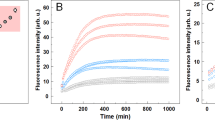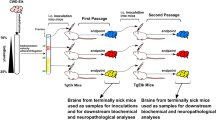Abstract
The development of a short incubation model of scrapie (strain 263K), in golden hamsters1,2, has added impetus to the purification of the infectious agent. Our own attempts3 have been based on methods pioneered by Millson4,5 and developed by Prusiner6,7. We present here results indicating that a purification factor of up to 104 with respect to protein may now be possible. Fractions from brain with high infectivity had a sedimentation range of 70–300S and contained an abundance of fibrils closely similar to the scrapie-associated fibrils (SAF) discovered by Merz et al.8,9. Material of molecular weight (Mr) 26,000, which is probably protein, appears to be a major constituent of the fibrils. The association between infectivity and fibrils raises two possibilities: the fibrils are an infectious form of the scrapie agent or they are a pathological response to scrapie infection.
This is a preview of subscription content, access via your institution
Access options
Subscribe to this journal
Receive 51 print issues and online access
$199.00 per year
only $3.90 per issue
Buy this article
- Purchase on Springer Link
- Instant access to full article PDF
Prices may be subject to local taxes which are calculated during checkout
Similar content being viewed by others
References
Kimberlin, R. H. & Walker, C. A. J. gen. Virol. 34, 295–304 (1977).
Kimberlin, R. H. & Walker, C. A. J. gen. Virol. 39, 487–496 (1978).
Diringer, H., Hilmert, H., Simon, D., Werner, E. & Ehlers, B. Eur. J. Biochem. 134, 555–560 (1983).
Millson, G. C., Hunter, G. D. & Kimberlin, R. H. in Slow Virus Diseases of Animals and Man (ed. Kimberlin, R. H.) 243–266 (North-Holland, Amsterdam, 1976).
Millson, G. C. & Manning, E. J. in Slow Transmissible Diseases of the Nervous System Vol. 2 (eds Prusiner, S. B. & Hadlow, W. J. ) 409–424 (Academic, New York, 1979).
Prusiner, S. B. et al. Biochemistry 17, 4993–4999 (1978).
Prusiner, S. B. et al. Proc. natn. Acad. Sci. U.S.A. 78, 6675–6679 (1981).
Merz, P. A., Somerville, R. A., Wisniewski, H. M. & Iqbal, K. Acta neuropath. Berl. 54, 63–74 (1981).
Merz, P. A., Somerville, R. A. & Wisniewski, H. M. in Unconventional Viruses and Diseases of the Central Nervous System (ed. Court, L.) 259–281 (Masson, Paris, 1983).
Diringer, H. & Kimberlin, R. H. Biosci. Rep. 3, 563–568 (1983).
Bolton, D. C., McKinley, M. P. & Prusiner, S. B. Science 218, 1309–1310 (1982).
Prusiner, S. B. et al. Biochemistry 21, 6942–6950 (1982).
Merz, P. A., Somerville, R. A., Wisniewski, H. M., Manuelidis, L. & Manuelidis, E. E. Nature 306, 474–476 (1983).
Bruce, M. E., Dickinson, A. G. & Fraser, H. Neuropath. appl. Neurobiol. 2, 471–478 (1976).
Gelderblom, H., Bauer, H., Frank, H. & Wigand, R. J. gen. Virol. 1, 553–560 (1967).
Laemmli, U. K. Nature 227, 680–685 (1970).
Oakley, B. R., Kirsch, D. R. & Morris, N. R. Analyt. Biochem. 105, 361–363 (1980).
Author information
Authors and Affiliations
Rights and permissions
About this article
Cite this article
Diringer, H., Gelderblom, H., Hilmert, H. et al. Scrapie infectivity, fibrils and low molecular weight protein. Nature 306, 476–478 (1983). https://doi.org/10.1038/306476a0
Received:
Accepted:
Issue Date:
DOI: https://doi.org/10.1038/306476a0
This article is cited by
-
Prions in Microbes: The Least in the Most
Journal of Microbiology (2023)
-
Innate immunity to prions: anti-prion systems turn a tsunami of prions into a slow drip
Current Genetics (2021)
-
Prion protein PrP nucleic acid binding and mobilization implicates retroelements as the replicative component of transmissible spongiform encephalopathy
Archives of Virology (2020)
-
Nuclease resistant circular DNAs copurify with infectivity in scrapie and CJD
Journal of NeuroVirology (2011)
-
Observing fibrillar assemblies on scrapie-infected cells
Pflügers Archiv - European Journal of Physiology (2008)
Comments
By submitting a comment you agree to abide by our Terms and Community Guidelines. If you find something abusive or that does not comply with our terms or guidelines please flag it as inappropriate.



